Polar Dinosaur Fossils From Jurassic Suggest They Did Survive Even In The Cold
Did Dinosaurs Live In Snow has been a question that scientists have had for years. As new fossil discoveries continue to shed light on dinosaur habitats, there have also been discoveries in cold climates that could have been stomping grounds with cold climates. A dinosaur found in the Antarctic Peninsula has been a mystery for over 20 years. This discovery was made in 1991 by paleontologists, who discovered an unidentified species of dinosaur that they named Cryolophosaurus ellioti. According to the fossil record, this species lived about 147 million years ago and is one of only three dinosaurs whose remains have ever been found in Antarctica. It makes me wonder, is it possible snowy habitats existed during the Mesozoic, and did dinosaurs live in snow?
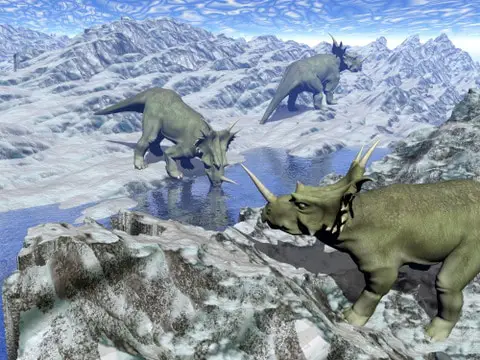
Did Dinosaurs Live in Snow?
Dinosaurs have been found in snow-covered areas of the world. In the Arctic – specifically Canada, Alaska, Greenland – and Antarctica, suggesting that some dinosaurs could withstand cold temperatures, even for months at a time. These cold-surviving dinosaurs are known as polar dinosaurs. Polar dinosaurs adapted to cold snow climates and darkness by having great resistance to cold temperatures, strong night vision, and possibly being warm-blooded.
Key Takeaways
- Cryolophosaurus ellioti is an Antarctic dinosaur, living around 147 million years ago.
- Polar dinosaurs adapted to the cold with night vision and possibly being warm-blooded.
- They were mostly herbivores but occasionally ate meat, making them omnivorous.
- Polar dinosaurs may have migrated to regions like Alaska and Australia.
- Some had adaptations for surviving in snow, like insulation and possibly bioluminescence.
- The extinction of polar dinosaurs is uncertain, possibly due to starvation or environmental changes.
Earth’s geological history unveils a mesmerizing tapestry where dinosaurs, those impressive reptiles, held center stage. Questions concerning their habitats, particularly if dinosaurs endured climatic extremes like snow, interest researchers and enthusiasts alike. Paleontologists, relentlessly investigating diverse fossils, attempt to map this intriguing aspect of dinosaur existence, focusing on possible adaptations that indicate survival in extensive cold weather conditions.
Historical climatic periods like the Ice Age, predominated by cold weather and significant snow, differ from the warm environments typically linked with dinosaurs. Yet the duration of the Dinosaur Era, spanning beyond the well-known Jurassic into the Triassic and Cretaceous periods, hints at a spectrum of climatic episodes, suggesting potential adaptability in diverse conditions.
Table of Contents
Researchers draw connections between different types of dinosaurs and the geographically varied locations of their fossils. These connections provide a comprehensive understanding of the environment and weather conditions pivotal to dinosaur survival. But pondering on whether changes in the weather environment led to their extinction opens a broad field of study.
Exploring the geographic locations where dinosaur fossils were discovered indicates the possible climates that dinosaurs might have survived. Such data substantially contributes to researching dinosaur adaptability and the Earth’s ancient climatic conditions, essential for resolving the mystery surrounding their extinction.
Reconstructing the past within the context of the climatic conditions demonstrates the adaptive capabilities of these ancient beasts. This endeavor deepens our understanding of Earth’s past, revealing a fascinating narrative interweaving dinosaurs, their habitats, their adaptability, and their demise. This narrative continues to evolve as our quest for unearthing knowledge marches onward.
There are more fossil discoveries and evidence that supports the idea of polar dinosaurs. Consider these facts and statistics:
- Migration: Some polar dinosaurs, similar to modern-day Arctic terns, may have migrated to the poles during the summer and retreated to warmer climates during the winter. It is suggested that they traveled up to 3,200km (1,988 miles). (Source)
- Nesting in the Arctic: Fossil evidence suggests that dinosaurs may have given birth and lived year-round in the Arctic over 70 million years ago. (Source)
- Feathers: Newly discovered polar dinosaurs have been found to have worn feathers as fluffy, insulated coats. The discovery of diverse feather types in polar dinosaurs has expanded our understanding of the evolution of feathers. (Source)
One of the most iconic dinosaurs known to man is Triceratops. These colossal beasts were a type of herbivorous dinosaurs that lived in North America during the late Maastrichtian age of the Upper Cretaceous Period.
Fossil records that indicate this dinosaur were also prevalent in today’s southern Canada and northern Mexico. It was these areas where they would have migrated from during warmer periods towards more tropical regions for food and water as polar winters became colder and food scarce.
What are polar dinosaurs? Where did they live, and how did they adapt? In today’s post, we’ll talk all about the dinosaur species that lived in cold climates as well as what their advantages were. You won’t want to miss it!
What Are Polar Dinosaurs? What Do We Know About Them?
Dinosaur fossils have been located in such frigid parts of the world, suggesting that some dinosaurs could withstand cold temperatures, even if these lasted for half the year. These cold-surviving dinosaurs are known as polar dinosaurs.
It may be your first time hearing about polar dinosaurs. What are these creatures, and what separates them from normal dinosaurs?
Polar Habitats That Dinosaurs Lived In
As the name implies, polar dinosaurs were more equipped to live in freezing cold, even polar conditions. The polar climate is one where summer days are far longer than average (a single day could be the equivalent of several days), and winter days go by quickly. Even still, there’s no reprieve in the summertime, as the temperatures are still cool to cold.
Two examples of places today that have polar conditions are Antarctica and the Arctic. For an example of what average winter temperatures are like, in Antarctica, the average temperature is -70.6 degrees Fahrenheit. Closer to the coast, the temperatures increase to around 14 degrees.
Yes, these are extremely cold temperatures, but not so cold that people can’t withstand them. There are people out there who live in Antarctica.
Dinosaurs once lived here, too, although what the temperatures were like at the time is hard to say. In its piece on polar dinosaurs, Science Magazine suggests that since the earth’s rotational axis changed during the Mesozoic Era, the days may have been longer and the temperatures creating somewhat of a warmer climate than what we know polar conditions to be today.
That said, the temperatures could have varied depending on where on earth polar dinosaurs called home. In Alaska’s Northern Slope and southeastern Australia, for instance, temperatures were quite different. Science Magazine says that life on the North Slope might have regularly meant temperatures of 35.6 to 46.4 degrees, with a high average of 53.6 degrees.
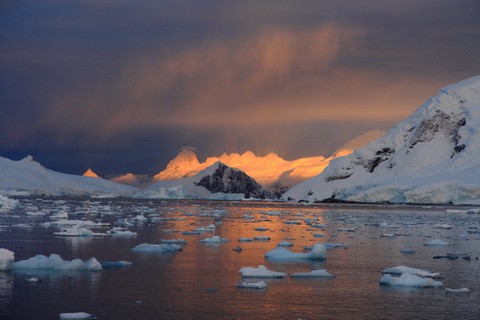
Australia at the time was in a different location than it is today and would have been considered part of the Antarctic Circle.
Some Key Things We Know About Polar Dinosaurs
● Although polar dinosaurs were mostly herbivores or plant-eating dinosaurs, they occasionally ate meat, making them omnivorous dinosaurs (eating both plants and meat). If you want to know more about omnivore dinosaurs, check out my article – What Did Omnivorous Dinosaurs Eat? Surprising Facts About Omnivores.
● These snow dinosaurs lived in the Arctic Circle and were also found to have existed in Antarctica, Canada, and Greenland. Some paleontologists believe that Antarctic dinosaurs and Arctic dinosaurs were migratory and, as such, would have migrated to and from polar regions.
● The first carnivorous polar dinosaur found in Antarctica was discovered in 1991 and named Cryolophosaurus ellioti. Polar dinosaur fossils in the Arctic regions have been found in the early 1900s.
How Did Polar Dinosaurs Survive in the Snow?
In addition to colder temperatures, polar dinosaurs are thought to have spent much of the year in complete darkness (winter darkness), at least six months.
To survive in the snow, polar dinosaurs had a few things to adapt to the climate and habitat. For one thing, their bodies were designed for living in cold environments where they had plenty of insulation from fur or feathers that would have helped keep them warm and protect them from freezing. Secondly, it turns out many types of these creatures could produce light through bioluminescence which may have allowed them to see more clearly in dark times and give off heat as well!
Pulling all this information together, here three key traits that many polar dinosaur species exhibited.
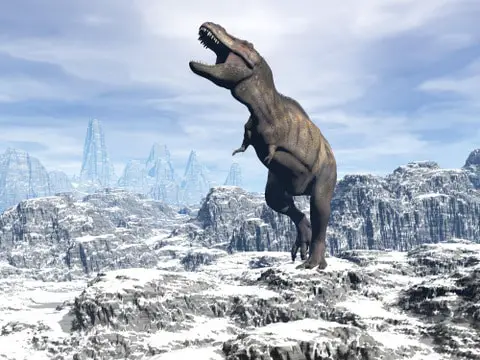
Possibly Warm-Blooded
Once upon a time, the belief was that dinosaurs absolutely were not warm-blooded creatures. These days, as more and more information about dinosaurs becomes available, not all scientists agree. This Live Science piece from 2015 sheds some light on the debate, suggesting that qualities such as dinosaur teeth, their energy consumed, and their energy rates might have made some species warm-blooded.
Being warm-blooded makes sense for polar dinosaurs, as it means they could produce heat at a greater rate than they lose it. It would allow them to stave off the cold, something these dinosaurs had to excel at to survive in polar conditions.
That said, warm-bloodedness can be sort of like a double-edged sword at times. If a creature is too small and warm-blooded, they can’t retain their body heat as well, which causes them to lose it faster. Only bigger warm-blooded creatures can stay warm through the temperature of their blood, so this very well may have been a case of only the larger dinosaurs survive.
| Aspect | Pro Warm-Blooded | Contra Warm-Blooded |
|---|---|---|
| Prevailing Belief | Once upon a time, the belief was that dinosaurs absolutely were not warm-blooded creatures | – |
| Current Debate | These days, as more and more information about dinosaurs becomes available, scientists are starting to question the old belief | Some scientists still adhere to the old belief |
| Evidence | This Live Science piece from 2015 suggests that qualities such as dinosaur teeth, their energy consumed, and their energy rates might have made some species warm-blooded | – |
| Benefits for Polar Dinosaurs | Being warm-blooded makes sense for polar dinosaurs, as it means they could produce heat at a greater rate than they lose it. This would allow them to stave off the cold, something these dinosaurs had to excel at to survive in polar conditions | – |
| Drawbacks of Being Warm-Blooded | Warm-bloodedness can be a double-edged sword at times. If a creature is too small and warm-blooded, they can’t retain their body heat as well, which causes them to lose it faster | Size may work against being warm-blooded |
| Survival of Larger Dinosaurs | Only bigger warm-blooded creatures can stay warm through the temperature of their blood, so this very well may have been a case of only the larger dinosaurs survive | – |
Strong Night Vision
Evolution tells us that creatures like dinosaurs had to adapt to their conditions to survive. As we said in the paragraphs above, for at least half the year, dinosaurs that lived in polar conditions were bathed in complete darkness. They’d have the moonlight, but that was the only natural light available.
Without being able to see in the darkness, polar dinosaurs would have died quickly because they wouldn’t hunt. These dinosaurs adapted their vision so they could see even in the pitch blackness. We can’t say how good their night vision is, but what’s certain is these dinosaurs did possess at least some form of night vision.
It isn’t exactly unheard of. There is strong evidence of carnivorous dinosaurs that also boasted night vision to feed at night and during the day. Thus, it seems more likely that polar dinosaurs would have night vision too.
Great Cold Resistance
Whether it was exclusively through their warm-bloodedness or other means, polar dinosaurs had to have a strong resistance to the cold. Perhaps they had thick skin or feathers, so the whipping winds and frigid temperatures didn’t bother them as much. To learn more about dinosaur skin, read my article: What Does Dinosaur Skin Feel Like? The Bumpy Textures Explained! Maybe they lived in the warmer parts of polar regions. Whatever it was, there has to be some reason the cold temperatures didn’t bother these dinosaurs.
Notable Polar Dinosaurs
There are only a few places where scientists have found fossil evidence of dinosaurs that can be identified and classified in these polar regions. I’ll narrow in on one such place.
Prince Creek Formation in Alaska’s Northern Slope was a habitat that many polar dinosaurs lived in during the Late Cretaceous Epoch, referred to as the Early Maastrichtian. We’re fortunate enough to have fossils of a handful of types of dinosaurs that called this polar woodland home. Here are some such species.
Pachyrhinosaurus
The Pachyrhinosaurus comes from a Greek term that means “thick-nosed lizard.” The snout of these dinosaurs was indeed quite bulbous. Remains of the Pachyrhinosaurus have been found in Alberta, Canada, and the Prince Creek Formation, including several Pachyrhinosaurus skulls and other bones.
This ornithischian was categorized into three different species, P. perotorum, P. canadensis, and P. lakustai. The dinosaur was about 26 feet in length with a weight of four tons. Teeth in the cheeks of the Pachyrhinosaurus aided them in breaking down plants and leaves, as this species was an herbivore.
The bosses that went over its eyes and nose were flat yet horn-like. The Pachyrhinosaurus did have horns elsewhere, namely, its frill and its skull.
Alaskacephale
A pachycephalosaurid, the Alaskacephale, lived up to 80 million years ago. This polar dinosaur species was discovered very recently, in 2005. The “kephale” part of its name is the Greek word for head, as the Alaskacephale had a head with a protruding, rounded top. More information is still being uncovered about this interesting dinosaur.
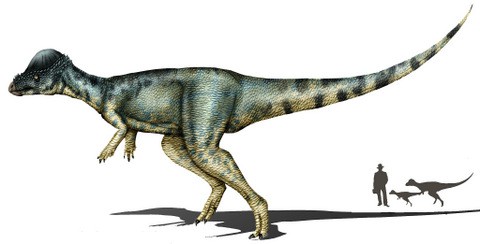
The interesting thing about the Alaskacephale is that it was a smaller-sized version of other pachycephalosaurs found in Montana in the U.S., which had a pronounced bump on the skull and a crown of spikes. If you are interested in reading more about Pachycephalasaurs, check out my article What Was The Dinosaur With The Bump On Its Head? The Hard-Headed Dinos.
Troodon
The Troodon was at one point mistaken for a lizard. Since some lizards did inhabit areas of polar conditions, that makes the Troodon’s environment fitting. Alberta, Canada’s Dinosaur Park Formation, is one popular spot to find fossils of the Troodon outside of the Prince Creek Formation.
Its name is a Greek word that means “wounding tooth,” as the Troodon’s teeth were serrated and quite noticeable, which is not so much the case with other theropods. Troodons probably weren’t very big dinosaurs, but they likely had long tails that could have been used as a weapon in addition to those ferocious teeth.
Nanuqsaurus
Nicknamed the “polar bear lizard,” the Nanuqsaurus is one of the best examples of polar dinosaurs we’ve got. The Nanuqsaurus and its one species, the Nanuqsaurus hoglundi, may have been relatives of the T-Rex, although they didn’t look much alike.
Interestingly, depictions of the Nanuqsaurus show that the dinosaur’s body had either fur or feathers, even if paleontologists from the fossil bones haven’t confirmed this detail. The body covering could have been its means of survival against the cold, long, dark days the polar dinosaurs lived through.
The Nanuqsaurus was thought to be about 20 feet long with a weight of up to 2,000 pounds. The distinct head ridge is where its T-Rex familial bonds originated from. It may also share some relationship with the Zhuchengtyrarnnus and the Tarbosaurus.
Ugrunaaluk – The Hadrosaur
Ugrunaaluk kuukpikensis is an Edmontosaur, which is a duck-billed dinosaur. The name means “ancient grazer” in Inupiaq, the language of Alaska’s North Slope region. Its fossils were found near Kotzebue, Alaska. This particular hadrosaur has a distinctive nasal crest that makes its appearance unique (for a hadrosaur). In 2020, paleontologists confirmed that it was an Edmontosaurus, despite earlier giving it its own genus.
The fossils date back to the Late Cretaceous Period and are about 75 million years old. These polar hadrosaurs most likely walked around the snowy landscapes in a herd and used their many rows of grinding teeth to eat tough plants like mosses. They were massive creatures that reached over 30 feet long, walking on their hind legs and using their arms to balance as they grazed. (Source)
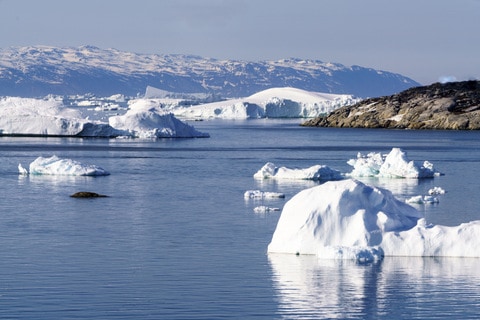
Dromaeosaurus
Finally, the Dromaeosaurus is known as the “swift running lizard” in Greek. Unearthed in Canada and Alaska, this dino had a large skull like the T-Rex (but no relationship) as well as strong, sharp teeth. There are at least seven species of Dromaeosaurus.
The dinosaur was probably only 6.6 feet long and weighed about 33 pounds, making the Dromaeosaurus tiny and lightweight. Its feet exhibited a sickle claw, which was a curved claw that could have been used during hunting or as a self-defense measure.
————————————————————————————————
Related Dinosaur Articles You Might Also Be Interested In:
Herbivore Dinosaurs – What’s So Cool About Them? (Types, Sizes, Facts)
What Did Omnivorous Dinosaurs Eat? Surprising Facts About Omnivores
What Are Long Neck Dinosaurs (Types, Size, List)?
————————————————————————————————
What Killed Polar Dinosaurs?
Polar dinosaurs seemed so well-adapted to the cold, so what was it that eventually lead to their undoing? It wasn’t volcanic winter or impact winter, that seems certain.
Allow us to explain for a moment. You see, as asteroids and comets plummeted to earth during the Cretaceous-Paleogene extinction event, an impact winter may have occurred. At the very least, some sudden climate change did happen, possibly a volcanic winter caused by the drying volcanic ash.
One theory is that because migratory dinosaurs that traveled to warmer climates died (or the journey became too difficult), the carnivorous dinosaurs that remained in the cold regions died of starvation. Scarcity of plants would have also impacted the polar regions and snow dinosaurs if the environment changed drastically.
Either way, polar dinosaurs could have lived through harsh cold environments as the temperatures didn’t bother them. That said, between asteroid collisions and molten volcanic lava, it wasn’t safe to be in the environment the dinosaurs were naturally trapped in. As for now, experts aren’t sure exactly what killed polar dinosaurs. Hopefully, someday, we know!
Parting Shot
Although there’s still a lot of research to be done on polar dinosaurs, the info we do have paints a picture of a fascinating group of dinos that could outlive conditions that not all species could.
The discoveries of polar dinosaur fossils in Canada, Alaska, Antarctica, and Australia prove that these chilly-climate creatures weren’t just clever or lucky enough to survive the Arctic climates. They were warm-blooded and had night vision, which they might have used for finding food in their frigid habitat, as well as hiding from predators like T. Rex, who may not have been able to function at such a low temperature. The only other two kinds of dinosaurs known to be warm-blooded are birds and mammals, making them an extremely rare find!
Frequently Asked Questions
When did dinosaurs live in snow?
It is possible that some dinosaurs lived in snow-covered regions, based on the fossils found. The majority of fossils found in polar regions date to the Jurassic and Cretaceous periods.
What is the climate like during the time of dinosaurs?
During the time of dinosaurs, the climate varied greatly. In some regions, there were icy and snowy conditions.
Did dinosaurs thrive in cold climates?
Some dinosaurs may have been able to survive and even thrive in cold climates.
Were dinosaurs cold-blooded?
Yes, dinosaurs were cold-blooded, which means their body temperature depended on the temperature of their environment.
How did dinosaurs survive in freezing temperatures?
Dinosaurs adapted to survive in freezing temperatures by developing certain physiological and behavioral characteristics.
Where have dinosaur remains been found in snow and ice?
Dinosaur remains have been found in Arctic regions, such as northern Alaska.
Is there evidence that dinosaurs lived in cold environments?
Yes, there is evidence that some dinosaurs lived in cold environments and were adapted to such conditions.
How did dinosaurs adapt to the cold?
Dinosaurs adapted to the cold by developing insulating features, such as feathers or thick scales.
Did dinosaurs have any adaptations for snowy or icy conditions?
Some dinosaurs had adaptations, such as large sizes or unique body structures, that helped them survive in snowy or icy conditions.
Did dinosaurs lay eggs in cold climates?
It is possible that dinosaurs laid eggs in cold climates, as they were known to nest in various environments.
